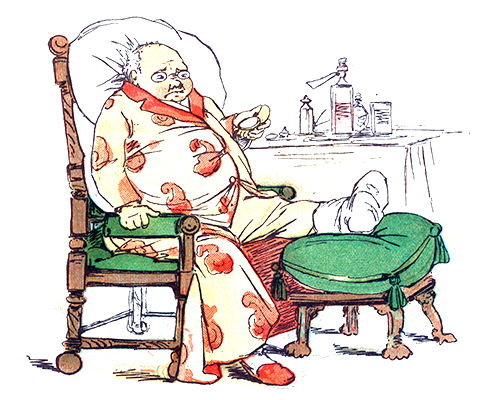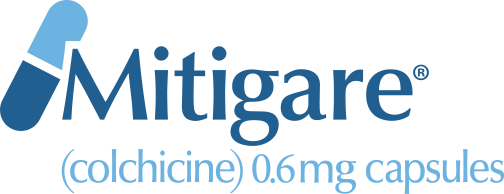
First identified by the Egyptians around 2640 BC, gout is one of the earliest known diseases.1 Millions of people (mostly men) still suffer with it today.2 Fortunately, scientists have learned a lot about this potentially debilitating condition over the past few thousand years.2,3 Read on to find out more about the history of gout disease.
Identifying the cause
Although the ancient Egyptians were the first to recognize it1, the first official clinical description of gout came from Hippocrates (460–370)3. About a century later, Aretaeus the Cappadocian proposed that gout disease was caused by a toxin in the blood (later identified to be uric acid).3
Naming the condition
The first person known to use the word “gout” was the Dominican monk Randolphus of Bocking in the early 1200s.1 The term comes from the Latin word gutta, or “drop.”1 In those days, it was believed that an excess of one of the four “humors” (bodily fluids, which, when balanced, were thought to maintain health) would flow or “drop” into a joint, causing pain and inflammation.1 Variations of the term are used to this day across a number of languages—the English “gout,” the French “goutte,” the Spanish “gota,” the Italian “gotta” and the German “gicht.”3
Understanding gout disease
In the seventeenth century, a number of advances were made in the science of gout.3 Englishman Thomas Sydenham was the first to recognize the chronic and acute aspects of gout disease (hyperuricemia and gout attacks, respectively).3 He also differentiated gout from other forms of arthritis.3 Anton von Leeuwenhock, inventor of the microscope, was the first to examine and describe tophi, finding that it was made up of the tiny, needle-like particles that Swedish chemist Carl Scheele later identified as urate crystals.3
Advancing the science
The next major contributor to the study of gout was physician and professor Alfred Baring Garrod.3 He conducted his groundbreaking research at the University of London, demonstrating the relationship between high levels of uric acid in the bloodstream and the development of gout.3 His son, Archibald, carried on his father’s work, making strides in the science of gout disease well into the 20th century.3
Searching for relief for gout disease
Many different methods have been used to manage gout over the years. Early treatments from Hippocrates’ day included barley water, purging and counterirritation (scorching the veins near the affected joint).3 Bloodletting was also very popular among physicians at the time.3 These “treatments” would be used for the next 1000 years.3
Introducing colchicine
Although there is evidence that colchicine was used in ancient Greece more than 2000 years ago, it was first used as a specific treatment for gout by Byzantine physician Alexander of Tralles around 600 AD.1 Not long after that, colchicine fell out of use for several hundreds of years, only to be rediscovered by Austrian physician Baron Anton de Storck in the mid-1700s.1 Perhaps the most notable user of an early form of colchicine was Benjamin Franklin.3 therapy (eg, Mitigare® [Colchicine] 0.6 mg Capsules, Generic Colchicine Capsules) is still used today to prevent gout flares.4
Discovering treatments for gout disease
More than a hundred years passed before the next major advance in gout management.1 Urate-lowering therapies (ULTs), which help the body flush out uric acid via the kidneys, were first used in the late 1800s.1 In the 1940s, a ULT called allopurinol was discovered by drug manufacturer Burroughs Wellcome.5 Allopurinol ultimately earned a Nobel Prize in Physiology and Medicine for Gertrude B Elion and George H Hitchings5, and is considered the most commonly used ULT even today6.
Making gout flares history
If gout flares are a part of your health history, you may be able to make them a thing of the past. Talk with your doctor about how a ULT such as may be able to help reduce your uric acid level5 and how Mitigare® (Colchicine) 0.6 mg Capsules may be able to help you prevent gout attacks.
Mitigare® is a registered trademark of Hikma Pharmaceuticals USA Inc.
Important Safety Information
Colchicine 0.6 mg capsules are contraindicated in patients with renal or hepatic impairment who are currently prescribed drugs that inhibit both P-gp and CYP3A4. Combining these dual inhibitors with colchicine in patients with renal or hepatic impairment has resulted in life-threatening or fatal colchicine toxicity. Patients with both renal and hepatic impairment should not be given Mitigare®.
Fatal overdoses have been reported with colchicine in adults and children. Keep Mitigare® out of the reach of children.
Blood dyscrasias such as myelosuppression, leukopenia, granulocytopenia, thrombocytopenia, and aplastic anemia have been reported with colchicine used in therapeutic doses.
Monitor for toxicity and if present consider temporary interruption or discontinuation of colchicine.
Drug interaction with dual P-gp and CYP3A4 inhibitors: Co-administration of colchicine with dual P-gp and CYP3A4 inhibitors has resulted in life-threatening interactions and death.
Neuromuscular toxicity and rhabdomyolysis may occur with chronic treatment with colchicine in therapeutic doses, especially in combination with other drugs known to cause this effect. Patients with impaired renal function and elderly patients (including those with normal renal and hepatic function) are at increased risk. Consider temporary interruption or discontinuation of Mitigare®.
Please see the full Prescribing Information and Medication Guide for Mitigare® for complete product details.
NOTE: This article was not written by a medical professional and is not intended to substitute for the guidance of a physician. These are not Hikma’s recommendations for gout flare prevention, but rather facts and data collected from various reliable medical sources. For a full list of resources and their attributing links, see below.
